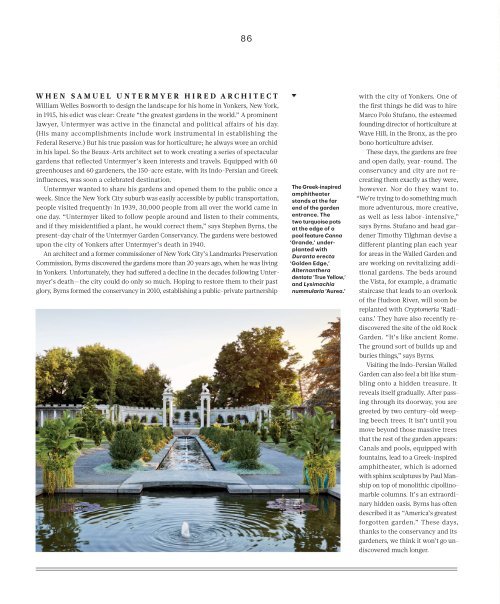MarthaStewartLivingOctober2015
Create successful ePaper yourself
Turn your PDF publications into a flip-book with our unique Google optimized e-Paper software.
86<br />
WHEN SAMUEL UNTERMYER HIRED ARCHITECT<br />
William Welles Bosworth to design the landscape for his home in Yonkers, New York,<br />
in 1915, his edict was clear: Create “the greatest gardens in the world.” A prominent<br />
lawyer, Untermyer was active in the financial and political affairs of his day.<br />
(His many accomplishments include work instrumental in establishing the<br />
Federal Reserve.) But his true passion was for horticulture; he always wore an orchid<br />
in his lapel. So the Beaux-Arts architect set to work creating a series of spectacular<br />
gardens that reflected Untermyer’s keen interests and travels. Equipped with 60<br />
greenhouses and 60 gardeners, the 150-acre estate, with its Indo-Persian and Greek<br />
influences, was soon a celebrated destination.<br />
Untermyer wanted to share his gardens and opened them to the public once a<br />
week. Since the New York City suburb was easily accessible by public transportation,<br />
people visited frequently: In 1939, 30,000 people from all over the world came in<br />
one day. “Untermyer liked to follow people around and listen to their comments,<br />
and if they misidentified a plant, he would correct them,” says Stephen Byrns, the<br />
present-day chair of the Untermyer Garden Conservancy. The gardens were bestowed<br />
upon the city of Yonkers after Untermyer’s death in 1940.<br />
An architect and a former commissioner of New York City’s Landmarks Preservation<br />
Commission, Byrns discovered the gardens more than 20 years ago, when he was living<br />
in Yonkers. Unfortunately, they had suffered a decline in the decades following Untermyer’s<br />
death—the city could do only so much. Hoping to restore them to their past<br />
glory, Byrns formed the conservancy in 2010, establishing a public-private partnership<br />
The Greek-inspired<br />
amphitheater<br />
stands at the far<br />
end of the garden<br />
entrance. The<br />
two turquoise pots<br />
at the edge of a<br />
pool feature Canna<br />
‘Grande,’ underplanted<br />
with<br />
Duranta erecta<br />
‘Golden Edge,’<br />
Alternanthera<br />
dentata ‘True Yellow,’<br />
and Lysimachia<br />
nummularia ‘Aurea.’<br />
with the city of Yonkers. One of<br />
the first things he did was to hire<br />
Marco Polo Stufano, the esteemed<br />
founding director of horticulture at<br />
Wave Hill, in the Bronx, as the pro<br />
bono horticulture adviser.<br />
These days, the gardens are free<br />
and open daily, year-round. The<br />
conservancy and city are not recreating<br />
them exactly as they were,<br />
however. Nor do they want to.<br />
“We’re trying to do something much<br />
more adventurous, more creative,<br />
as well as less labor-intensive,”<br />
says Byrns. Stufano and head gardener<br />
Timothy Tilghman devise a<br />
different planting plan each year<br />
for areas in the Walled Garden and<br />
are working on revitalizing additional<br />
gardens. The beds around<br />
the Vista, for example, a dramatic<br />
staircase that leads to an overlook<br />
of the Hudson River, will soon be<br />
replanted with Cryptomeria ‘Radicans.’<br />
They have also recently rediscovered<br />
the site of the old Rock<br />
Garden. “It’s like ancient Rome.<br />
The ground sort of builds up and<br />
buries things,” says Byrns.<br />
Visiting the Indo-Persian Walled<br />
Garden can also feel a bit like stumbling<br />
onto a hidden treasure. It<br />
reveals itself gradually. After passing<br />
through its doorway, you are<br />
greeted by two century-old weeping<br />
beech trees. It isn’t until you<br />
move beyond those massive trees<br />
that the rest of the garden appears:<br />
Canals and pools, equipped with<br />
fountains, lead to a Greek-inspired<br />
amphitheater, which is adorned<br />
with sphinx sculptures by Paul Manship<br />
on top of monolithic cipollinomarble<br />
columns. It’s an extraordinary<br />
hidden oasis. Byrns has often<br />
described it as “America’s greatest<br />
forgotten garden.” These days,<br />
thanks to the conservancy and its<br />
gardeners, we think it won’t go undiscovered<br />
much longer.
















